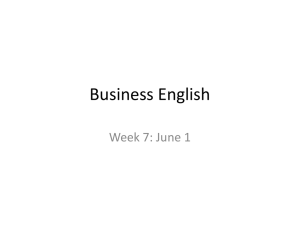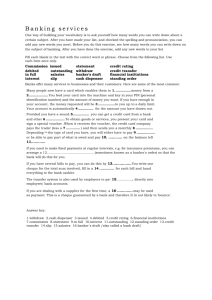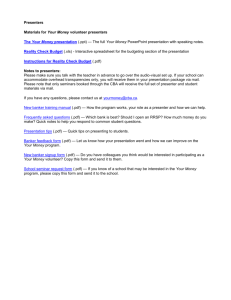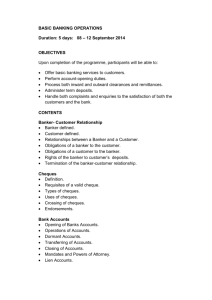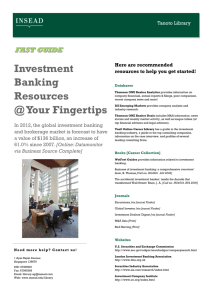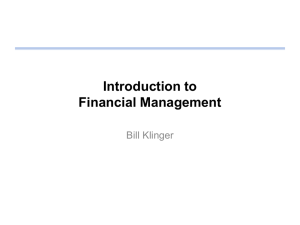Trust-Based Selling…the new 5Cs
advertisement
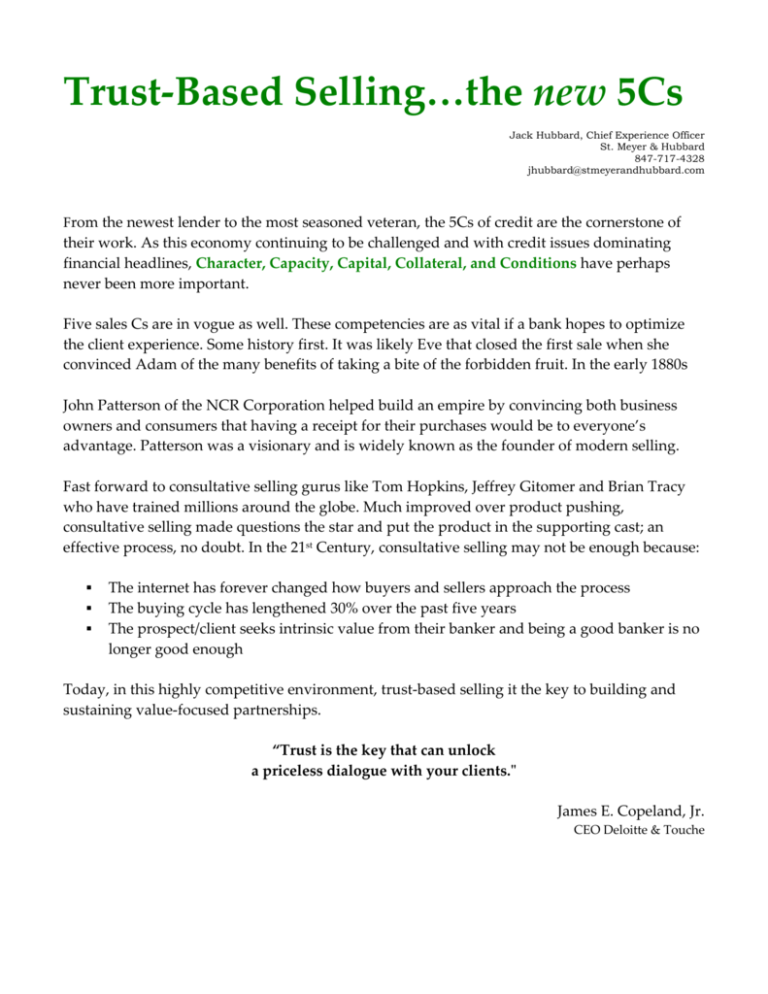
Trust‐Based Selling…the new 5Cs Jack Hubbard, Chief Experience Officer St. Meyer & Hubbard 847-717-4328 jhubbard@stmeyerandhubbard.com From the newest lender to the most seasoned veteran, the 5Cs of credit are the cornerstone of their work. As this economy continuing to be challenged and with credit issues dominating financial headlines, Character, Capacity, Capital, Collateral, and Conditions have perhaps never been more important. Five sales Cs are in vogue as well. These competencies are as vital if a bank hopes to optimize the client experience. Some history first. It was likely Eve that closed the first sale when she convinced Adam of the many benefits of taking a bite of the forbidden fruit. In the early 1880s John Patterson of the NCR Corporation helped build an empire by convincing both business owners and consumers that having a receipt for their purchases would be to everyone’s advantage. Patterson was a visionary and is widely known as the founder of modern selling. Fast forward to consultative selling gurus like Tom Hopkins, Jeffrey Gitomer and Brian Tracy who have trained millions around the globe. Much improved over product pushing, consultative selling made questions the star and put the product in the supporting cast; an effective process, no doubt. In the 21st Century, consultative selling may not be enough because: The internet has forever changed how buyers and sellers approach the process The buying cycle has lengthened 30% over the past five years The prospect/client seeks intrinsic value from their banker and being a good banker is no longer good enough Today, in this highly competitive environment, trust‐based selling it the key to building and sustaining value‐focused partnerships. “Trust is the key that can unlock a priceless dialogue with your clients.ʺ James E. Copeland, Jr. CEO Deloitte & Touche In 2006, Charles Green followed his now business classic, The Trusted Advisor with the best seller, Trust‐Based Selling. This practical look at selling in the 21st Century articulates how transparent collaboration is the best way to develop trust. Here’s what Mr. Green suggests on his website, www.trustedadvisor.com. “Trust‐Based Selling is not an oxymoron. The gains of trust‐based buyer/seller relationships can and do accrue to both parties. People prefer to buy what they have to buy anyway from those they have come to trust. It is possible for selling to be a genuinely value‐adding, beneficial process for buyer and seller alike. But in order for it to work, we as sellers actually have to care about our customer so uncommon.” The New 5Cs Sales in banking has begun to turn a corner. Accountability‐based Performance Cultures have replaced event‐driven Sales Cultures. Inwardly focused cross selling is supplanted by client‐ centric cross solving. The customer experience surpasses “service” as a means to create loyalty. Into this mix falls the new 5Cs of trust‐based selling: Conversations Curiosity Collaboration Customization Coaching Conversations…the ultimate differentiator Recent data indicates 10‐12 touches are needed (letter, e‐mail, voice mail) before a cold prospect agrees to see a banker. Data also suggests 54% of business bankers stop touching after the first rejection. A 2007 CSO Insights study also suggests it takes an average of seven calls for a prospect to become a client. Given those statistics how can sales professionals create differentiation? It’s all about the conversation. Well planned conversations targeted to the needs of the client build trust and move process forward faster. Banks that have analyzed why their bankers do not get back in the door for a second call have found their bankers are too eager to present versus ask or “pitch” versus “catch.” Buyers have answers, sellers have the questions is a great mantra to live by as a sales banker. Here are a few best practices we’ve seen work well: © 2008 St. Meyer & Hubbard, Inc. A business banker in Maine emails several impactful Thought Starter questions ahead as a preliminary agenda. This approach not only shows the prospect the banker has prepared for the conversation, it helps focus the meeting. Talk about differentiation. A Relationship Manager in the Midwest brings a laminated sheet of discovery questions to an initial call that get the discussion going: − − − − − − − − − − − − Where have you BEEN? Where are you NOW? Where are you GOING? How do you plan to get there? What stands in your way of achieving those goals? Talk about the top three initiatives here in the next 6‐12 months. What is your timeframe for those objectives? What issues will you face if you do or don’t execute on your initiatives? How are decisions made here relating to choosing financial partners? What criteria will you use in selecting that partner? Where are you in this process? What mistakes do banks make when they attempt to build trust‐based relationships with clients? A lender in the south uses First Research to customize industry‐specific questions to the seven basic financial needs each business has. She is getting back in the door for a second call over 70% of the time. © 2008 St. Meyer & Hubbard, Inc. Curiosity…creating the cliff hanger How does American Idol or any recurring television series keep viewers tuning in week after week? They always leave the audience wanting more. Premature presentations have always been a challenge for bankers. A quarter over quarter revenue mentality (Peppers and Rogers calls it the crisis of short termism) has made matters worse. This conflict of results now has taken inquisitiveness to a new low. Curiosity is controlled by the sales associate. The banker determines when to stop asking and start talking. They determine what is brought along as a leave behind on an initial call. There is a difference between building curiosity and manipulating the situation. It is critical to be transparent as a sales person. To build curiosity the banker can: Carefully consider what he or she brings along on each call. One bank encourages its calling staff to bring the following on an initial call; business cards, two pens that work, a note pad, a copy of their calendar 30‐60 days out, a value‐focused leave behind and an open mind. The leave behind is interesting The bank calls is PowerResrouces – a list of sales and marketing books the business owner can use to become more effective and productive. No annual reports, no pitch books, no brochures. This is about the prospect, not the bank. Do it right and there will be plenty of time to share collateral. Be more interested than interesting. Some banks subscribe to the theory that employing a memorized “elevator speech” or “value proposition presentation” creates differentiation. Instead it causes eyes to glaze over and certainly tells the business owner the banker in front of them is no better or different than what they have now. Redirect. Answer a question with a question. Some call that the Socratic Model. When the CFO asks about cash management products, the banker can be ready with three or four questions about; what the business is doing now, how it is working, how technology is involved etc. The great sales person earns the right to present by uncovering as many issues as possible. When the business banker starts the conversation process, the business owner is imaging “Do I see myself banking with this person?” When the sales person always leaves the call on a WOW note, the pre‐client will think “I wonder what the next conversation with this banker will sound like?” When the salesperson sets that tone, he or she will always have a better than average chance to get back in for another call and another call and… © 2008 St. Meyer & Hubbard, Inc. Customization…remove the generic It isn’t possible to tailor every product for every situation. It is easy to understand, however, that every business owner buys remote capture, an HSA, a loan for their own reasons. As the banker presents his or her solutions, therefore, landing those features and benefits in the life of every buyer in a manner that is best for them, creates a propensity for the buyer to say “yes.” Gaining knowledge as to “why” they buy can occur in the first or second meeting if the sales person is adept at the Curious. Issues about the reasons for the services they have or believe they need, what type of a banking relationship works for them and criteria for their buying decisions all factor into future presentations. One large bank we know employs the Sant Proposal Software which allows the banker to quickly customize presentations based on the objectives and needs of individual clients and prospects. Other banks employ Chief Marketing Officer to help assemble tailored presentation documents. For more great tips about customization and a terrific newsletter about how to create this 1 to 1 mindset, visit Peppers and Rogers at www.peppersandrogers.com. Collaboration…the ultimate in transparency Working together works. Unfortunately sales is many times seen as a war or a chess game. It is important for the sales person to understand if there is a “fit” between the philosophy and the abilities of the bank and the vision the company has of what a banking relationship should be. If there is a mismatch during the sales process it won’t improve after the sale is made. In Trust‐Based Selling Charles Green discusses the ultimate in transparency as the salesperson and the prospect assembling the proposal together. The banker discusses the margin they need and the value they bring to the table. When there is nothing to hide the dialogue is elevated to a collegial level and less negotiation is needed. Coaching keeps the culture in motion None of the first four Cs occurs without an ongoing commitment to reinforce the process. Great sales coaches understand they manage numbers and lead people. In his soon‐to‐be classic book Go Put Your Strengths to Work, Marcus Buckingham suggests: “Our people aren’t our greatest asset. The strengths of our people are.” © 2008 St. Meyer & Hubbard, Inc. There is a fallacy that constantly working with sales associates on deficits help improve results. Rather, a great sales coach helps his or her people improve their strengths to pull the culture to the next level. From a 5Cs perspective sales managers might ask themselves: How do I regularly reinforce conversations, curiosity, customization and collaboration? What tools am I using to optimize our sales process? How do I interweave my vision of the client experience into team meetings and individual interactions with associates? During my one on ones with associates how much do I focus my conversations on results versus doing the right activities and behaviors? During joint calls what is my role and how am I trying to observe the other 4Cs? Jack Hubbard is Chief Experience Officer at St. Meyer & Hubbard. He is a regular presenter at state and national banking conferences as well as serving on the faculty of the nation’s top banking schools. To register for Conversation Signposts, St. Meyer & Hubbard’s monthly newsletter or to receive information about Conversations with Prospects, the company’s first book, visit www.stmeyerandhubbard.com. © 2008 St. Meyer & Hubbard, Inc.
